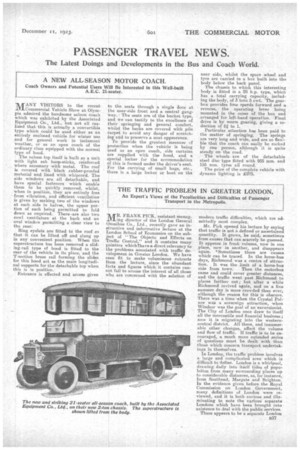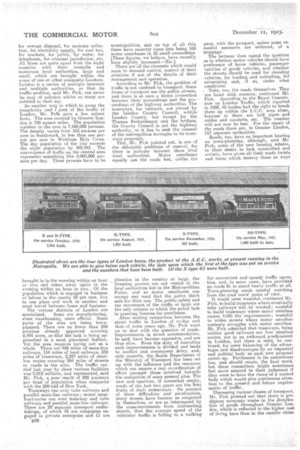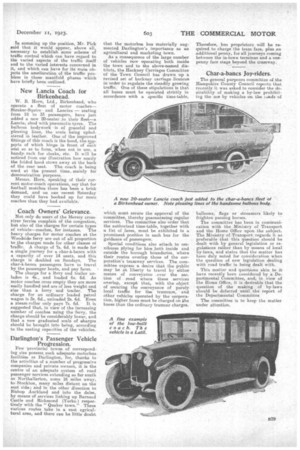THE TRAFFIC PROBLEM IN GREATER LONDON.
Page 21

Page 22

Page 23

If you've noticed an error in this article please click here to report it so we can fix it.
An Expert's Views of the Peculiarities and Difficulties of Passenger Transport in the Metropolis.
TR. FRANK PICK, assistant manag_01..-ing director of the London General Omnibus Co., Ltd., recently gave an instructive and informative lecture at the London School of Economics on the subject of " The Objects and Effects on Traffic Control," and it contains many pointers whichthavee direct relevancy to the problems associated with traffic development in Greater London. We have seen fit to make voluminous extracts from the lecture, since the abundant facts and figures which it contains cannot fail to arcaise the-interest Of all those who are concerned with the solution of
modern traffic difficulties, which are admittedly most. complex.
Mr. Pick opened his lecture by saying that traffic is not a defined or ascertained quantity. It grows, he said, sometimes from causes that can scarcely be guessed. It appears in fresh • volume, now in one ,place, now in another, and disappears again. *Sometimes there are causes which can he traced. In the horse-bus days, Richmond was a centre of attraction. It was the limit of a horse-bus
ride from. town. Then the motorbus came and could cover greater distances, and the traffic, went past Richmond to places farther out; but alter a while Richmond revived again, and on a fine sumnier day is more crowded than ever, although the reason for this is obscure. There was a time when the Crystal Palace wao a sovereign attraction, when Windsor was the goal of an -excursionist. The City of London once drew to itself all the mercantile and financial business; now it is migrating into the Westerncentral district. All these, and innumerable other changes, affect the volume and flow of traffic. If traffic is to be encouraged, a much more extended series of questions must be dealt with than these which concern transport undertakings in themselves.
In London, the traffic problem involves alarge and complicated area' which is difficult to define. London is a whirlpool, drawing daily into itself tides of population from many surrounding paces up to considerable distances, as, for instance, from Southend, Margate and Brighton. In the evidence given before the Royal Commission on London Government, many definitions of London were reviewed, and it is both curious and illu. minating to note the various separate Londons which have been brought into existence te deal with the public services. There appears to he a separate London
for sewage disposal, for customs collection, for electricity supply, for coal tax, for markets, for police, for water, for telephones, for criminal jurisdiction, etc. All these are quite apart from the eight counties with their councils and numerous local authorities, Large and small, which are brought within the scope of one or other composite Londons. London is a centre of multiple interests and multiple authorities, so that its traffio problem, said Mr. Pick, can never be easy of solution whilst so many are entitled to their say.
As another way in which to grasp the complexity and f ...Sent of the traffic of London, Mr. Pitlk gave a few salient facts. The area covered by Greater London is 700 square miles. The population resident in the area is 7,500,000 persons. The density varies from 163 persons per acre in Southwark, to less than one person per acre iT1 Waltham Holy Cross. The day population of the city exceeds the night population by 402,441. The convergence of traffic on the central area represents something like 3,000,000 persons per day. These persons have to be
brought in in the morning within an hour or two and taken away again in the evening within an hour or two. Of the population which is engaged in business or labour in the county 60 per cent, live in one place and work in another and must travel between home and business.
The various districts of London are
apecialized. Some are manufacturing, some warehousing, some official. Some parts of the area are being townplanned. There are no fewer than 289 schemes already approved covering 8,404 acres, so that the task is being approached in a most piecemeal fashion. Yet the area requires laying out as a whole. There are 499 miles of main-line railways, 154 miles of local railways, 350 miles of tramways, 2,357 miles of oinnibns routes covering 894 miles of streets or roads in the area. The traffic carried last year by these various facilities was 2,913 millions, and represented, said Mr. Pick, a poor result of 390 journeys per headof population when compared with the 500'odd of New York.
Tramways run over tube railways and parallel main-line railways; motor omnibushroutes run over tramway and tube railways and parallel main-line railways. There are 29 separate transport undertakings, of which 18 are companies engaged in private enterprise and 11 are 'n38 municipalities, and on top of all this there have recently come into being 162 motor omnibuses in 55 small ownerships. [These figures, we believe, have recently been slightly increased.—En.] There are all the elements which would seem to demand control, control of their relations if not of the details of their management and operation.
According to Mr. Pick, the problem of traffic is not confined to transport. Some forms of transport use the public streets, and there is at once a direct connection between their Proceedings and the proceedings of the highway authorities. The tramways, for instance, are owned by the London County Council, within London County, but except for the Thames Embankment and the bridges, the County Council is not the highway. authority, so it has to seek the consent of the metropolitan boroughs to its tramways proposals.
This, Mr. Pick pointed oot, is one of the debatable problems. of control, for there is jealousy between these rival local authorities. Motor omnibuses equally use the roads but, unlike the
_ situation in the country at large, the -licensing powers are not vested in the local authorities but in the Metropolitian Police, and BO motor omnibuses can occupy any road that the police think fade for their use. The public safety and the movement of the traffic at large are the only criteria to which the police look in granting licences for omnibuses. After making comparison between the street traffic in London of to-day and that of some years ago, Mr. Pick went on to deal with the question of roads. Improvements in street accommodation, he -said, have become expensive, and are thus slow. Even the duty of executing such improvements is divided and leads to conflict and consequent delay, and, only recently, the Roads Department of the Ministry of Transport has been set up with the influence and the resources which can ensure a real co-ordination of effort amongst those involved towards the realization of some general plan. The new and spacious, if somewhat empty, roads of the last two years are the first fruits of their endeavours. On account of these difficulties and peculiarities, many streets have become so congested in themselves, or are so interrupted by the cross-movements from intersecting street's, that the average speed of the vehicular traffic is falling to a walking
pace, with theprospect, unless some remedial measures are enforced, of a stoppage. The lecturer then raised the question as to whether motor vehicles should have preference of horse vehicles, passenger vehicles of goods vehicles, and whether the streets ahould be usedfor standing vehicles, for loading and, unloading, for advertising and, if so, under what conditions.
Take, too, the roads themselves. They
• are beset, with enemies, continued Mr. Pick. According to the Royal Commission OD London Traffic, which reported
• in 1903, 46 bodies had the right to break them up within the L.C.C. area alone, because in them are laid. pipes and cables and conduits, etc. The number will not now be less. For the repair of the roads there are, in Greater Landon, 117 separate authorities. Roads, too, have an important bearing on town-planning, although, said Mr. Pick, some of the new housing estates, in their desire to look countrified and artistic, have given all their roads twists and turns which destroy them as ways for convenient and speedy traffic operation, and, in some cases, have provided no roads fit to stand heavy traffic at all. Town-planning needs careful watching from the road users' point ofview. It would seem wasteful, continued Mr. Pick, to build tramways whore eventually tube railways will be wanted; wasteful to build tramways where motor omnibus routes fulfil the requirements; wasteful to widen streets where motor omnibus uselessly struggles with motor omnibus. Mr. Pick admitted that tramways, being neither good railways nor free omnibus routes, are in an awkward. predicament in London, but there is need, he contuned, for some balancing of the advantages and disadvantages by an impartial and Pidicial body as each new proposal comes up. Parliament in its committees has, and should retain, the final word, but these committees might sometimes feel more assured in their judgment if they were to have the views of a control body which would give continuous attention to the present and future requirements of traffic.
Discussing various classes of transport, Mr. Pick pointed out that there is prodigious economic waste in the distribution of goods throughout Greater London, which is reflected in the higher coat of living here than in the smaller cities. In summing up the position, Mr. Pick said that it would appear, above all, necessary to establish_ some scheme of traffic control which can have regard to the varied aspects of the traffic itself and to the varied interests concerned in it, and which can have for its main objects the amelioration of the traffic problem in those manifold phases which have briefly been outlined.
New Lancia Coach for Birkenhead.
W. B. Horn, Ltd., Birkenhead, who operate a fleet of motor coaches- Straker-Squire and Lancias — seating from 18 to 33 passengers, have just added a new 20-seater to their fleet—a Lancia, shod with pneumatic tyres. The bulbous bodywork is of graceful and pleasing lines, the seats being upholstered in leather. One of the improved fittings of this coach is the hood, the supports of which hinge in front of each seat so as to form, when not in use, a handy. rack for cloaks, etc. It will be noticed from our illustration how neatly the folded hood stows away at the back
of the rear -seat. The coach is being used at the present time,.m-ainly for demonstration purposes.
Messrs. Horn, speaking of their current motor-coach operations, say that, for football matches there has been a brisk demand, and on one recent Saturday they could have booked up far more coaches than they had available.
Coach Owners' Grievance.
Not only do users of the Mersey crossriver ferries complain of the congestion, but also of the charges for certain types of vehicle—coaches, for instance. The heavy charges for motor coaches at, the Woodside ferry are out of all proportion te_the charges made for other classes of traffic. A charge of 7s. 6d. is made for a single journey for a char-a-bancs with a capacity of over 14 seats, and this charge is doubled on Sundays. The char-a-hence passengers have to travel by the passenger boats, and pay fares.
The charge for a Rory and trailer unladen. is 4s., and loaded 6s: 6d. As motor coaches cross empty they are more easily handled and are of less weight and size than a lorry and trailer. The charge for an ordinary loaded petrol wagon is 3s. 6d., unloaded 2s. 6c1: Even a steam-roller only pays 7s. 6d. It is suggested that, in view of the increasing number of coaches using the ferry, the charge should be considerably lower, and that a new graduated scale of charges should be brought into being, according to the seating capacities of the vehicles.
Darlington's passenger Vehicle Progression.
Few provincial towns of corresponding size possess, such adequate•motorbus • facilities as Darlington, for, thanks to the activities of a number of progressive companies and private owners, it is the centre of an adequate system of road passenger services extending so far south as Northallerton, some 16 miles away, to Stockton, many miles distant on the east side; and in the other direction to Bishop Auckland and into the dales, by means of services linking up Barnard Castle and Richmond (Yorks.) respectively with the " Quaker town." These various routes take in a vast agricultural area, and there can be little doubt that the motorbus has materially augmented Darlington's importance as an agricultural and marketing town. As a consequence of the large number of vehicles now operating both inside the town and to the above-named districts, the Hackney Carriages Committee of the Town Council has drawn up a revised set of hackney carriage licences in order to regulate the steadily growing traffic. One of these stipulations is that all buses must be operated strictly in accordance with a specific time-table,
which must secure the approval of the committee, thereby guaranteeing regular services. The committee also order that the authorized time-table, together with a list of .fares, must be exhibited in a prominent position in each bus for the guidance of passengers.
Special conditions also attach to omnibuses plying for hire both inside and outside the borough boundaries, where their routes overlap those of the corporation's tramway services. The committee express a desire that the public may be at liberty to travel by either means of conveyance over the section of road where these services overlap, except that, with the object of securing the conveyance of purely local traffic for the tramc,ars, and other vehicles operated by the corporation, higher fares must be charged on the buses than the ordinary tramcar charges. Therefore, bus proprietors will be required to charge the tram fare, plus an additional penny, for all journeys coming between the in-town terminus and a onepenny fare stage beyond the tramway.
Char-a-bancs Joy-riders.
The general purposes committee a the Hampshire County Council reports that, recently it was asked to consider the desirability of making a by-law prohibiting the use by vehicles on the toads of
balloons, flags or streamers likely to frighten passing horses.
The committee has been in communication with the Ministry of Transport and the Home Office upon the subject. The Ministry of Transport regards it as preferable that this question sbould be dealt with by general legislation or regulations rather than by means of local by-laws, and states that the matter has been duly noted for consideration when the question of new legislation dealing with road traffic is. being dealt with.
This matter and questions akin to it have recently been considered by a Departmental Committee, and, in view of the Home Office, it is desirable that the question of the making of by-laws should be deferred until the report of the Departmental Committee The committee is to keep the matter under attention.
































